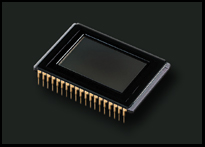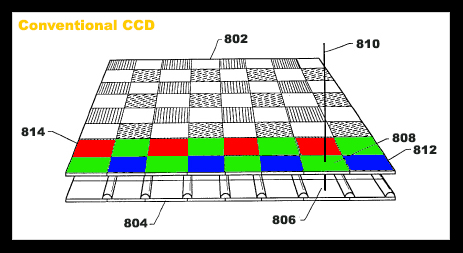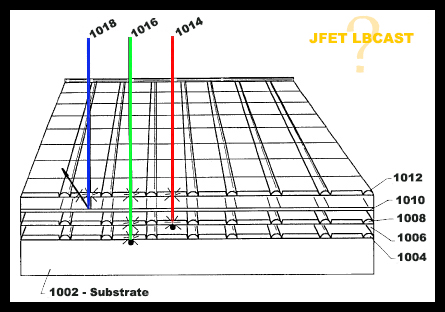
 |
||||||||||||||||||
The JFET LBCAST Sensor (July 25, 2003) Luminance-Priority Electronic Color Image Sensor? |
||||||||||||||||||
 |
||||||||||||||||||
Nikon's JFET LBCAST Imager has been on my mind recently. Why? Well, its not really CMOS, and it's not a CCD either. From reading news releases on DP websites, and reading about the D2h which will be the first DSLR to have this new imager, I was getting very curious. And here is what I found. This article will most likely get very technical, and I will try to explain it as well as I can. I would also like to make clear that my claim of this sensor being Nikon's choice, is an assumption on my part. There were just too many coincidences to overlook this sensor, and not draw a correlation. |
||||||||||||||||||
Luminance-Priority Electronic Color Image Sensor |
||||||||||||||||||
This is another name of what I believe Applied Science Fiction, Inc. is calling the JFET LBCAST sensor. The company was first reported by Phil Askey, of DPReview, who mentioned ASF, Inc's involvement (i.e, Kodak taking over Digital PIC Technology, and involvment in digital imaging). I decided to investigate further if there were any closer associations. |
||||||||||||||||||
What is Luminance-Priority? |
||||||||||||||||||
If you were to look at multilayer color film, it would be hard to actually say what specific color it was. The reason is because light hitting the film, is hitting hundreds of layers of transparent polymers, creating this interesting design. As you move the film around, the different angles are reflecting light at different lengths because of the angles. This is part of light theory, and how it relates to photography, and how film works in general. Different wavelengths of light, hitting different layers of film that react with it. When you take a picture with a film camera, the picture you see through your viewfinder, is hitting the film at different wavelengths and angles, creating a photo. On the other hand, let's take a look at how we view our world. Your eyes, my eyes, every human's eyes, see detail in luminance. We don't see things like a camera does, or in Red, Green, and Blue layers. Because of the way film is designed, it has to be "layered" so the appropriate wavelengths of light are triggered. Our eyes see things much differently than film. Detail is captured in this "luminance" layer, which resides on the top. This luminance layer is where the LBCAST sensor is said to gain much more detail and clarity, when used on an imager. Luminance-Priority Color Sensor (LPCS) Ingredients An LPCS, is a semiconductor base having several sensing elements disposed on the semiconductor base. These "sensing elements", are comprised of two features, which are a) at least one color sensing layer disposed outwardly from the semiconductor substrate, wherein the color sensing layer is able to measure an intensity of light within a frequency band corresponding to at least one color of light, and b) a luminance sensing layer disposed outwardly from the at least one color sensing layer, wherein the luminance sensing layer is operable to measure luminance. "The spirit of the present invention is to include in an electronic sensor a layer that substantially and generally matches the luminance response of the human eye..." says Applied Science Fiction, Inc. This is the key ingredient that is missing from your normal CCD or CMOS sensor. Remember, luminosity = detail. The more luminance you have, the more detail you have. It's kind of like using the sharpening tool in Photoshop. Photoshop's secret in sharpening a photo, is merely using more luminant colors (mostly white) around specific edges within the photo. Photoshop's algorhythms also tend to "lighten" the basic colors of an object's edges, to make it appear sharper. What Is A Luminance-Priority Color Sensor? "A color image sensor responsive to light from an exposing light source which includes a first sensitive layer with a first spectral sensitivity. The color image sensor also includes at least one second sensitive layer with a second spectral sensitivity different from the first spectral sensitivity. The second spectral sensitivity is offset from the first sensitive layer in a direction perpendicular to the plane of the first sensitive layer." - Applied Science Fiction, Inc. Regular CCD vs. A Luminance-Priority Color Sensor  Numbers Of Reference (the numbers I use are the same as Applied Sciene Fiction's patent submission) 802 - A color matrix (802) is laid over a CCD sensor (804), so each diode (806), has a color filter (808) over it, to filter a light ray (810) for that sensor element. This is a typical Bayer array, common in most digital cameras and other devices. 804 - CCD Sensor 806 - Diode 808 - Color filter (Green) 810 - Light ray 812 - Blue filter 814 - Red filter  Numbers Of Reference (the numbers I use are the same as Applied Sciene Fiction's patent submission) 1002 - The basic layer of a CCD. This apparently has not changed from the ordinary CCD. 1004 - A conventional CCD sensor array. Again, this is nothing new. 1006 - A red-absorbing, green transmitting filter is placed over 1004 (aka, an offset in register). This filter will be positioned underneath a yellow filter. 1008 - Another CCD sensor array is layered. Applied Science Fiction says that ..."this sensor must be built so the pixel site diodes are not opaque..." 1010 - Another yellow filter is placed over 1008. 1012 - A top sensor array is layed. 1014 - A red light ray (1014) is seen to penetrate and stimulate arrays 1012 and 1008 before being absorbed by the cyan filter 1006. 1016 - A green light ray (1016) is seen to penetrate and stimulate all three sensors 1012, 1008, and 1004. Green has maximum detectability. 1018 - A blue light ray (1018) is seen to stimulate only the top sensor 1012. Summary "Because each point in the image has equal access to each of the three color planes, a bright point or a narrow white line would be sensed as the same color independent of its alignment with the matrix. Thus all color moire artifacts are eliminated with the current invention." So, here is the difference between a CCD and the JEFT LBCAST sensor. The pixels on a sensor being placed in a digital camera, have EQUAL access to all 3 colors, red, green, and blue, versus a typical CCD that does not, and this is done by creating more filters that create a "reflection", equalizing all colors. This method reduces the effects of moire, because the colors are not dependent on alignment. Since the blue is reflecting twice, and red is inherently more influenced because of the design, we have an equal amount of light/luminance, hitting the sensors at the same time. I should also note that ASF, Inc., says the LBCAST sensor "...is a dramatic improvement over the prior [sensor] represented and makes practical a new world of available light to an emerging mass market of all electronic digital photography. In terms of freedom from color artifacts and image clarity, the present invention of a luminance priority sensor equals the prior "three chip" technology. In size and eventual cost, luminance priority equals the prior "single chip" technology. And in quantum detectability, the luminance priority color sensor equals prior monochrome technology, and therefore exceeds all prior art color technologies." A very ineteresting statement, don't you think? A single chip that is as effective as three separate chips of individual color detection. This could mean a change in not only digital cameras, but video cameras as well. Most of us were along the path of buying a 3-CCD high-end digital video camera. But now, this chip could change almost everything we have ever learned about imagers. Another example of its use would be in scanners. We still have yet to see examples, so this is just all theory. However, I welcome this change in imager technology. I should also note that Nikon is currently submitting several new manufacturing patents for what appears to be their new sensor, possibly derived from Applied Science Fiction. Conclusion I would like to emphasize again that Applied Science Fiction's LPCS and Nikon's association with Applied Science Fiction (as far as making this their sensor or this being their sensor they are going to make), is merely an educated guess on my part. I have no concrete knowledge that Nikon is going to make this same sensor. All I have, is information that is public knowledge, and I simply gathered that information on this page for a more condensed view. And finally, there may be more information added to make this sensor technology more understandable. If there is, I will certainly add it to this page.
|
|
Most of the information provided above was obtained by patent searching (including the examples which were modified to see easier), and specifically, patent #6,593,558. I have tried to condense a few major points, in order to understand the new Nikon sensor.
|
|